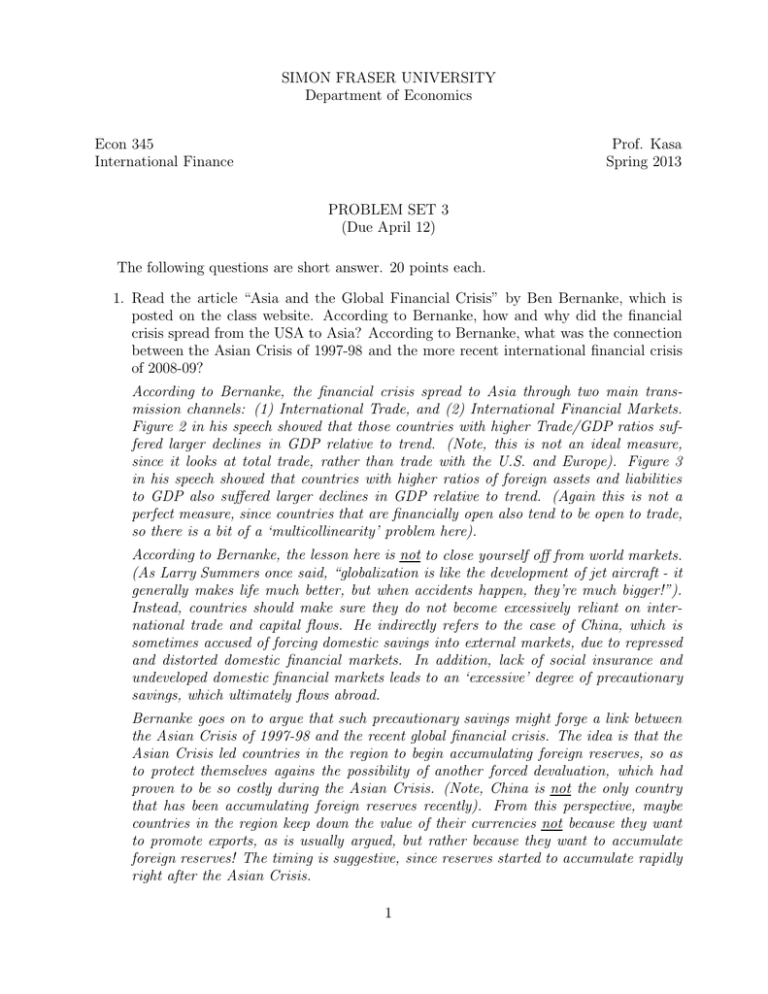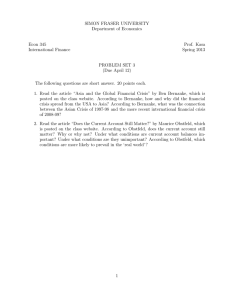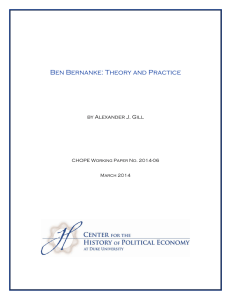SIMON FRASER UNIVERSITY Department of Economics Econ 345 Prof. Kasa
advertisement

SIMON FRASER UNIVERSITY Department of Economics Econ 345 International Finance Prof. Kasa Spring 2013 PROBLEM SET 3 (Due April 12) The following questions are short answer. 20 points each. 1. Read the article “Asia and the Global Financial Crisis” by Ben Bernanke, which is posted on the class website. According to Bernanke, how and why did the financial crisis spread from the USA to Asia? According to Bernanke, what was the connection between the Asian Crisis of 1997-98 and the more recent international financial crisis of 2008-09? According to Bernanke, the financial crisis spread to Asia through two main transmission channels: (1) International Trade, and (2) International Financial Markets. Figure 2 in his speech showed that those countries with higher Trade/GDP ratios suffered larger declines in GDP relative to trend. (Note, this is not an ideal measure, since it looks at total trade, rather than trade with the U.S. and Europe). Figure 3 in his speech showed that countries with higher ratios of foreign assets and liabilities to GDP also suffered larger declines in GDP relative to trend. (Again this is not a perfect measure, since countries that are financially open also tend to be open to trade, so there is a bit of a ‘multicollinearity’ problem here). According to Bernanke, the lesson here is not to close yourself off from world markets. (As Larry Summers once said, “globalization is like the development of jet aircraft - it generally makes life much better, but when accidents happen, they’re much bigger!”). Instead, countries should make sure they do not become excessively reliant on international trade and capital flows. He indirectly refers to the case of China, which is sometimes accused of forcing domestic savings into external markets, due to repressed and distorted domestic financial markets. In addition, lack of social insurance and undeveloped domestic financial markets leads to an ‘excessive’ degree of precautionary savings, which ultimately flows abroad. Bernanke goes on to argue that such precautionary savings might forge a link between the Asian Crisis of 1997-98 and the recent global financial crisis. The idea is that the Asian Crisis led countries in the region to begin accumulating foreign reserves, so as to protect themselves agains the possibility of another forced devaluation, which had proven to be so costly during the Asian Crisis. (Note, China is not the only country that has been accumulating foreign reserves recently). From this perspective, maybe countries in the region keep down the value of their currencies not because they want to promote exports, as is usually argued, but rather because they want to accumulate foreign reserves! The timing is suggestive, since reserves started to accumulate rapidly right after the Asian Crisis. 1 2. Read the article “Does the Current Account Still Matter?” by Maurice Obstfeld, which is posted on the class website. According to Obstfeld, does the current account still matter? Why or why not? Under what conditions are current account balances important? Under what conditions are they unimportant? According to Obstfeld, which conditions are more likely to prevail in the ‘real world’ ? According to Obstfeld, there are two quite distinct reasons why the Current Account might not matter: (1) In a world of ‘complete’ and perfect capital markets (Obstfeld cites Lucas (1982) as an example) countries agree ex ante to optimally share and diversify all their idiosyncratic, country-specific risks. For example, countries might buy and sell shares in each others stock markets. In such a world, the current account would indeed be irrelevant. Remember, the current account records net asset trades between countries, which reflect wealth transfers between countries. With perfect international financial markets, there would be no wealth transfers, since countries have already perfectly insured themselves. (Of course, there could be aggregate wealth effects, which affect all countries equally. But these would not trigger any asset trade.) Of course, this is a highly abstract and artificial world, but some people have argued that the recent explosive growth in gross asset flows has made the real world a better and better approximation of this world. (2) The second reason the current account might not matter is kind of the opposite of this. Some people have argued that rapid two-way asset trade simply reflects regulatory arbitrage, tax avoidance, and distorted incentives more generally. In this world, countries can build up large currency and maturity mismatches that expose them to huge risks, which may not be accurately reflected in the net transactions recorded by the current account. For example, most U.S. financial institutions appeared to be doing well on a flow basis in the years leading up to the financial crisis. In fact, their income statements showed that they were making record profits! However, a careful look at their balance sheets would have revealed huge risk exposures. Some people have argued that the same distinction is important at the overall country level. As a result, just looking at current account balances could be highly misleading. In fact, compared to a countries balance sheet, the current account is relatively unimportant. Obstfeld is clearly more sympathetic to the second argument. However, he does not agree with the argument that the growing importance of two-way asset trade has made the current account irrelevant. Wealth transfers are important, and the current account is the mechanism by which these transfers take place, and the mechanism by which world demand gets reallocated among countries. Instead, the growing importance of two-way asset trade just means that policymakers and regulators have more to worry about and monitor than they did before! 2





